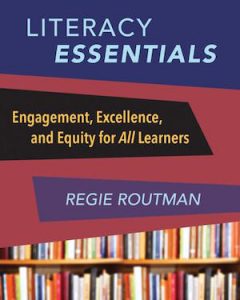Regie Routman is a longtime teacher, leader, author and storyteller. Her latest book, Literacy Essentials: Engagement, Excellence, and Equity for All Learners (Stenhouse 2018) distills the knowledge she has gained from decades of work with teachers and students, including many in high-challenge schools. Our thanks to her for sharing this excerpt on “frontloading” the teaching and learning process. Also see Regie’s second excerpt about being intentional and making no assumptions.
One of the biggest changes I’ve made as a teacher is to slow down to hurry up. By that I mean taking the necessary time for thinking, planning, demonstrating, and practicing to ensure students have adequate background, information, resources, competence, and support to do “the work.”
When we expertly frontload—that is, sufficiently prepare students before we release them to try and apply what we are teaching—almost all students are likely to succeed. Excellent teachers at every grade level and in all content areas use frontloading to optimize learning success for all students.
Although uncommon in practice, adequate frontloading is as necessary for high school students as it is for our youngest students. The same holds true for us teachers and leaders. When students and we are prepared, competent, and confident about the work we are about to undertake, we can maximize our time, efforts, and learning. As important, much less re-teaching is needed, which saves time and avoids frustration and loss of interest for our students and us.
About Frontloading
 Frontloading begins by consciously building a strong foundation of knowledge, processes, and strategies that will enable the learner to do the inquiry, problem solving, task, writing, reading, and so on, with minimal guidance and support. Continually assessing through teaching—before, during, and after—to determine what more needs to be asked, explained, modeled, adjusted, rethought, or revised is an essential part of the frontloading process. Such assessing is part of the ongoing responsive teaching that is a hallmark of highly effective teachers.
Frontloading begins by consciously building a strong foundation of knowledge, processes, and strategies that will enable the learner to do the inquiry, problem solving, task, writing, reading, and so on, with minimal guidance and support. Continually assessing through teaching—before, during, and after—to determine what more needs to be asked, explained, modeled, adjusted, rethought, or revised is an essential part of the frontloading process. Such assessing is part of the ongoing responsive teaching that is a hallmark of highly effective teachers.
Frontloading may include, but is not limited to, providing some or all of the following information and actions to and with our learners so that they are ready to effectively work by themselves with minimal guidance:
- Immersion in a real-world issue or genre (including noticing and naming features/qualities) through access to and interaction with excellent texts, multimedia, and relevant resources.
- Sufficient background knowledge.
- Pre-teaching vocabulary and concepts (e.g., when students wouldn’t be able figure it out by reading text).
- Demonstrations and thinking aloud by expert(s).
- Multiple shared experiences.
- Hearing and discussing stories and texts read aloud.
- Exploring related websites.
- Viewing videos on the topic; listening to related podcasts.
- Partner and small-group work.
- Checking for understanding throughout process.
- Raising important questions.
- Lots of opportunities for talk and guided discussion.
- Purposeful and thoughtful guided practice.
Teach Less to Teach More
Primary-grades teacher Trish Richardson reflects on how frontloading for a month preceding an in-depth study of an endangered species (polar bears) enriched her teaching and her students’ learning and writing outcomes:
While I have recognized for a long time the importance and value of frontloading, I have not frontloaded to the extent that I did with my class in this study, and the positive results were evident. Students were engaged in the topic because the topic was deep and rich, which enabled us to spend a great length of time on it.
Also, by the time students were ready to write, they all had a great deal of knowledge at their fingertips. When I sent students off to write, they were confident in themselves and their knowledge so that each and every student found their own voice. Students knew the information and it was so accessible to them that they were able to write in their own words with great success. Students became researchers, scientists, advocates for polar bears and, of course, non-fiction writers.
To be clear, when we are talking about frontloading, we are focusing on meaningful and relevant work and dialogue that pushes our students’ thinking, not preparing them for frivolous activities. (In my book Literacy Essentials, I devote a section to “Teaching with Purpose and Authenticity.”)
We are asking significant “big” questions that open up the conversations and provoke high-level thinking. We are reading and writing for real-world audiences and purposes. We are also very transparent and intentional about our goals and expected outcomes and check to ensure our students know and value these as well. Perhaps most important, we are using our curriculum as thought, or as Terry Heick put it, “to teach critical thinking, design, and problem solving—fluid intelligence….”
 Trish Richardson’s reflections illustrate a comprehensive study of an important topic that was connected to standards, curriculum, and real-world concerns. Trish’s evaluation also noted how study of one worthwhile topic over time (the threat of polar bear extinction) versus her past use of multiple writing projects made the quality of learning greater: “The less-is-more foundation allowed us to deepen our learning.” Not only that: the students invested their full energy because they fell in love with the topic and wanted to make a difference that went beyond themselves.
Trish Richardson’s reflections illustrate a comprehensive study of an important topic that was connected to standards, curriculum, and real-world concerns. Trish’s evaluation also noted how study of one worthwhile topic over time (the threat of polar bear extinction) versus her past use of multiple writing projects made the quality of learning greater: “The less-is-more foundation allowed us to deepen our learning.” Not only that: the students invested their full energy because they fell in love with the topic and wanted to make a difference that went beyond themselves.
(See more about the lesson in Appendix C – downloadable here – and examine the full lesson plan online, including frontloading charts, photos, and student work examples.)
It takes courage and a shift in beliefs to slow down, to take the necessary time for frontloading, and to teach for depth. One teacher told me that initially she didn’t believe that teaching less, but teaching more thoroughly, would pay off. It took until the middle of the school year for her to see that her students were actually much further along as readers and writers. Not only that: the number of students needing intervention had significantly decreased.
Seamless Teaching
Essentially, expert teaching through frontloading means we possess the foundation, skills, strategies, and knowledge to be adept at teaching all students to learn and find joy in learning.
Our deep knowledge of pedagogy, literacy, and content as well as our educational and life experiences make seamless teaching possible. That is, sufficient preparation, practice, tinkering, and reflection have brought us to the state where we are able to assess, adapt, and responsibly innovate during any lesson or collaboration with any group of learners.
Next time: Regie expands on her ideas about frontloading by emphasizing the importance of intentional teaching and making no assumptions without evidence. Read Part 2.
✸ ✸ ✸ ✸ ✸ ✸ ✸ ✸ ✸ ✸ ✸ ✸ ✸ ✸ ✸ ✸
 Regie Routman currently works on-site through a residency model in diverse schools and districts, coaching and mentoring principals, leaders at all levels, and teachers. She demonstrates effective instructional and assessment practices with the goal of creating and sustaining effective, intellectual, joyful cultures where all learners thrive as readers, writers, and responsible citizens.
Regie Routman currently works on-site through a residency model in diverse schools and districts, coaching and mentoring principals, leaders at all levels, and teachers. She demonstrates effective instructional and assessment practices with the goal of creating and sustaining effective, intellectual, joyful cultures where all learners thrive as readers, writers, and responsible citizens.
In addition to Literacy Essentials (browse the complete text at the Stenhouse site), Regie is the author of Reading Essentials, Writing Essentials, and Teaching Essentials. Visit regieroutman.org for more information on her many books, resources, blogs, professional offerings, and contact information.
You can see how frontloading fits into Regie’s Optimal Learning Model in this excerpt from her 2008 book Teaching Essentials.


0 Comments on "Regie Routman: Students Learn Best When We “Frontload” Lessons"